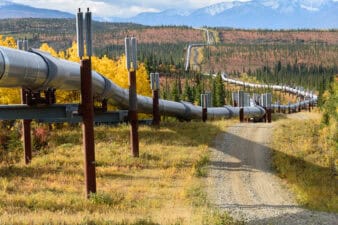One theory that’s been gaining considerable support in recent years is peak oil demand. Essentially, in around 20 to 30 years demand for oil will peak and then start to decline as renewable forms of energy and electric vehicles become more popular, causing the price of oil to fall sharply, particularly if supply continues to exceed demand.
While the impact on conventional and shale oil will be severe it is Canada’s oil sands that will be the hardest hit. This is not good news for major oil sands producers Imperial Oil Ltd. (TSX:IMO)(NYSEMKT:IMO) and Suncor Energy Inc. (TSX:SU)(NYSE:SU), which have vast undeveloped oil sands reserves.
What is peak oil demand?
Prominent oil industry consultancy Wood Mackenzie has predicted that global demand for crude will peak in 2036, which is significantly earlier than many oil majors are anticipating. While renewable sources of energy, notably for electricity generation, are expanding at a rapid clip, it is the rise of the electric vehicle that will trigger peak oil demand.
Wood Mackenzie believes that electric vehicles will be adopted at a faster pace than currently believed and that autonomous electric vehicles will be a game changer for the transportation industry.
Think tank Carbon Tracker Initiative believes that peak demand could arrive even sooner occurring by the late 2020s, as electric vehicles could displace up to two million barrels of crude production globally. This would have a sharp impact on oil prices especially in a world where supply already exceeds demand.
Oil sands among the hardest hit
While the impact would be felt across the energy sector, it is Canada’s oil sands which will be among the earliest and worst affected. This is because producing crude from the oil sands is a costly and energy intensive process. Various think tanks have determined that it is five to eight times more energy intensive than conventional and shale oil production.
It is also far more costly, meaning that is has higher breakeven costs than other forms of oil production. Analysts estimate that existing oil sands operations break even with oil at anywhere between US$40 to US$60 a barrel while new projects need crude to be at around US$90 a barrel to be economic. That compares to around US$40 a barrel for U.S. shale, US$30 to US$40 for conventional oil and US$30 for deep-water offshore.
The costs associated with oil sand production will increase because of Alberta and the federal government’s plans to introduce carbon pricing regimes, as the oil sands are the single largest emitter of greenhouse gases in Canada. While it’s unclear how much this will add to the cost of production, analysts believe that with WTI trading at US$60 or below carbon pricing could be a key factor in determining whether new oil sands projects are economic.
The advent of peak oil demand will only magnify these issues, making it even less economic to extract crude from Canada’s vast oil sands reserves.
Pushing ahead with new projects
Despite these issues, Imperial Oil is pressing ahead with the Aspen bitumen project, which on completion will add 75,000 barrels daily of bitumen production to its existing daily output of 393,000 barrels. This is a surprising move because of oil’s latest price collapse, which sees WTI trading at around US$50 or well below the projects breakeven cost.
Nonetheless, in similar circumstances, Suncor pushed ahead with the Fort Hills project, which came on line earlier this year and will eventually produce 194,000 barrels of bitumen daily despite analysts questioning the economics of the operation.
There is a very simple explanation for this. In a post-Paris Agreement world where global temperature increases are to be restricted to below 2 degrees Celsius above pre-industrial levels, a large portion of Canada’s oil sands reserves will become uneconomic to extract. This will only be aggravated by the earlier than expected arrival of peak oil demand. That means that Imperial Oil like Suncor is focused on extracting the maximum value from its existing oil reserves before it becomes uneconomic to do so.
Even if the widespread between WCS and WTI continues, which is likely for the foreseeable future, Imperial Oil can mitigate much of the impact because of its downstream business. The bitumen it produces is an important feedstock for its refining operations and depressed oil prices combined with the deep-discount applied to WCS. It means that Imperial Oil’s refineries can generate even greater margins, thereby boosting the profitability of its downstream business. This is evident from its third quarter 2018 results in which net income from refining surged by a massive 72% year over year.






